The shadow man: - always watching from afar, moving in a light, careful to discover one of his reservoir, is good at hiding, unite with the surrounding environment, calculate the speed of the wind and direction, standing Motzaza or lying down following his prey and adjusts the settings of his gun.
Working in the dark of the night or in the hustle of the day, participating in securing the attacking forces, or protecting the appearance of attackers, feared by all, and waiting for his existence, is the hidden hero, rarely seen on the battlefield or outside.
The majority of whom serve their own country, some of whom work for his personal benefit, yet history gives a suitable place to those and those who want to be mere shadows that do not advance, and most people do not know, even though they are the true creators of glory.
Here is an attempt to identify some of them, to highlight their most famous, and to highlight the important and decisive role they played in the determination of the destinies of conflicts, and the resolution of the results of wars, and despite the absence of the list of the name of Arab and despite the bad reputation that was associated in the minds of the Egyptians the title of sniper and his profession, The real sniper is stripped of his honor, and his bullets will not be criminalized if he starts from the barrel of his gun towards the enemies, not the hearts and eyes of his compatriots
- The Irishman and his stunning correction "Thomas Plunkett"
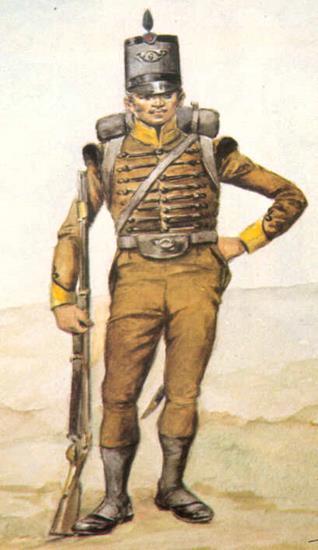
Thomas Blunkett is the first Irish soldier to join the British Sniper Battalion 95, and returns to the Battle of Cacabelos in 1809; Blanchett was able to kill French General Auguste Marie-François Collbert from a distance of nearly 600 meters. Sniper rifles are characterized by inaccuracy in the correction at the time, it seemed to everyone that Blunkett either be a sniper does not make him dust, or just lucky no more.
Which prompted Blunkett to repeat it, refilled a Baker sniper rifle and shot again, hitting a pilot who had rushed to help his wounded general. When his target hit his target for the second time in a row, Blunkett did so and retreated to see what he had done to his fellow men. Members of the 95th Division, and the astonishment of their features was to satisfy the pride of Blunkett, recognizing his exceptional skill as a unique sniper.
- Sergeant Grace, 4th Infantry Division "Sgt Grace & 4th Georgia Infantry"

Has this man really died? So General Ulysses S. asked. Grant suspects that men such as Grace may be killed by this great sniper.
Between the irony and disbelief came the sniper of the 4th Infantry Division of the South American Army during the American Civil War. The target was General John Sidwick, the military commander of the Northern Forces, after the skirmishes began in the Battle of Spotsylvania.
At the start of the battle, the southern separatist army snipers, the Sedwick soldiers, were forced to hide after being sprayed with bullets. The soldiers hurried to take shelter and take the barricades, and their general mocked them: "What? "You can not even hit the elephants from this distance?" They were only seconds away and hit the ground. Sergeant General Grace Sedwick's bullet down his left eye completely.
The general's eye was a thousand yards from the mouth of a British-British "British Whitworth" gun, a distance that was too far away by that time.
General Sidwick was the highest-ranking military officer who had died in the Northern Army, the Army of the Union, and his injury made Sergeant Grace of May 9, 1864 a famous history of all those who mention the American Civil War, the most prominent snipers, and of course the most prominent victims.
- Charles "Chuck" Maweni "Charles'Chuck'Mawhinney"

One of the greatest snipers of the Vietnam War, with 103 fatalities confirmed, surpassing the US Marines, legendary legend Carlos Hathcock, Charles achieved this stunning rate in 16 months. Although he joined the Marines at the age of 18 in 1967, Was revealed to the public only twenty years after the end of the war, and through a book whose author spoke extensively about Charles's dazzling skills as sniper, not many of his comrades knew about.
Charles then worked as a lecturer in the schools of sniper education, conveying to the new generations a summary of his vast experience as a sniper of the first category.
"It was a hunting trip in the absolute, a man snatching another man while the latter tries to kill me. Do not talk about hunting blacks and elephants. They do not fire your guns with sniper rifles and binoculars. I just liked it."
- Rob Furlong "Rob Furlong"
This figure is due in 2002, when the former Canadian army corporal Rob Verlong was involved in Operation Anaconda to pursue al-Qaeda military groups using his McMillan Tac-50 rifle. When he saw a group of three On the side of the mountain in the area in charge, Rob was quick to shoot and made a mistake the first time, hitting one of them on the back, but the third shot hit the target, although the time it took to reach the target was about three seconds long. The target group Bunched with the second shot of being attacked, but the third bullet lodged in spite of all this came from the leader of this group. - Vasily Zaytsev
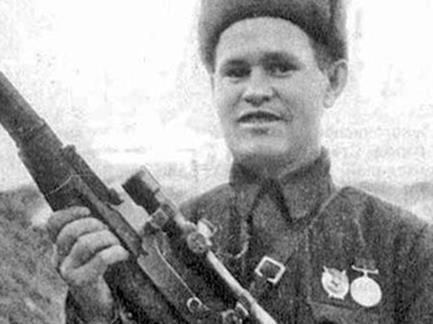
Well, the greatest prize I get was the sight of the German sniper Rifle Erwin Kónig, sent by the German command to eliminate."
The fact that Soviet sniper Zaitsev was in this fact, as an expression of his great losses in the ranks of the Third Reich soldiers, the hero of the legendary Stalingrad battle, was merely an ordinary Soviet naval officer. But as the conflict in the city named Joseph Stalin, The request for volunteerism and service in the front lines of the battle, and this was certainly bad for the Germans.
Zaitsev achieved a fatal and confirmed death rate of about 242 cases between October 1942 and January 1943, while the actual number may be as high as 500.
It is likely that Zaitsev is more on the list of the most famous, not only for his skill, but because Hollywood has known the world through one of the most famous films of war, the film "Enemy At The Gates," and despite the failure of the scenario of the film details of what really happened, The performance of Jude Law and Ed Harris was the reason for the immortality of this heroic sniper.
Zaitsev then opened a school to teach sniper, and the number of students killed by the rabbit - and this title - reached three thousand enemy soldiers, which is added to the record of the ruthless Soviet rabbit.
- Lyudmila Pavlichenko "Lyudmila Pavlichenko"
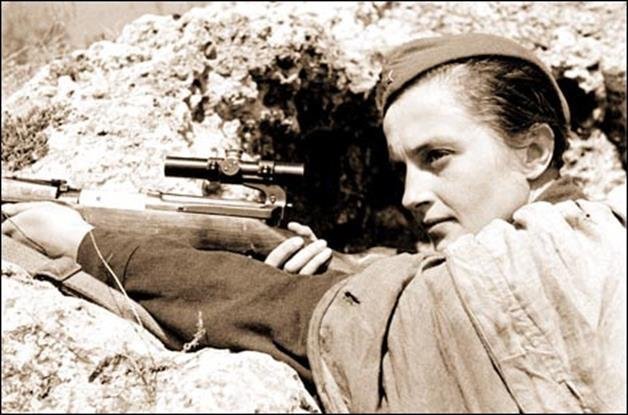
The woman who was granted glory was limited to men. It is rare for a woman to find such a cruel, violent, and inherently contradictory work with the female nature and composition. But the German invasion of Russia in the early 1940s prompted the twenty-four-year-old girl to join the Soviet army.
With the use of its Mosin-Nagant bolt action rifle, Lyudmila dropped one hundred eighty-seven German soldiers during the battles in Odessa. When troops were redeployed, they spent about eight months in Sevastopol on the Crimean peninsula, killing two hundred and fifty-seven Enemy soldiers, and to accomplish this has been mentioned by the Southern Army Council among the most prominent fighters of the war
The total number of casualties of the fatal killer confirmed in World War II three hundred and nine injuries, including thirty-six sniper !! A number that the specialists have depended on for a long time, impressed with the ability of Lyudmila to storm with her opponents.
- Corporal Francis Pegamagabow "Corporal Francis Pegahmagabow"
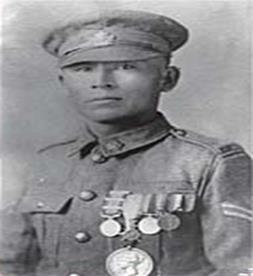
The first World War I marveled that three hundred and eighty-eight German soldiers were killed, more than 300 German soldiers were captured, three medals of military superiority were awarded, and two casualties were inflicted on the Jews. However, the Ojiboa warrior and the Canadians were forgotten after the end of the war. War and its return to Canada.
Not only did Francis do so, but he played a crucial role in delivering messages to and from his leadership despite the weight of the enemy's attack, directing relief efforts when his commander was injured, and even obtaining ammunition for his military unit when its stockpile was about to come into force.
All this was not enough for a man to get the respect he deserved after the war was over, confirming the racism that treats the origin of the origin of the Indians in North America, but the history of the great snipers preserved his proper place as one of the most prominent snipers of the First World War in particular, Generally.
- Adilbert F. And the "Adelbert F. Waldron"
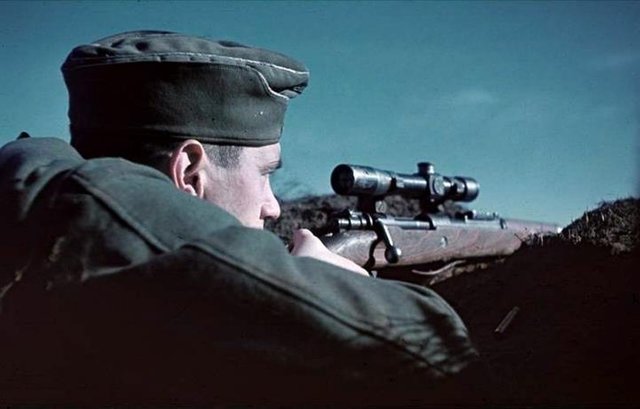
The Ladron carries the record for the largest number of victims of a US sniper in history, one hundred and nine fatal injuries, not only because of its fame, but also for its accuracy in shooting, especially from a mobile platform, the most difficult situation for any sniper.
Col. Michael Lee Lanning tells "Col. In his book "In the Target, Snipers in Vietnam," Michael Lee Lanning describes the ability of the superdrones, and that he and his companions were seen crossing the Mekong River with a Tango boat assigned to transport the armed soldiers, attacked by a Vietnamese Vietcong soldier, As panic swept over the boat, the dragon turned its gun and threw the enemy sniper out of the top of the coconut tree with only one shot.
It is impossible to overcome this level of accuracy and correction, despite the difficulty of the position of sniping and seriousness, and those who see otherwise to come forward to show us his skill, so was the tongue of Lanning and Aldron of course.
- The white-haired sniper "Carlos Norman Hathcock II"
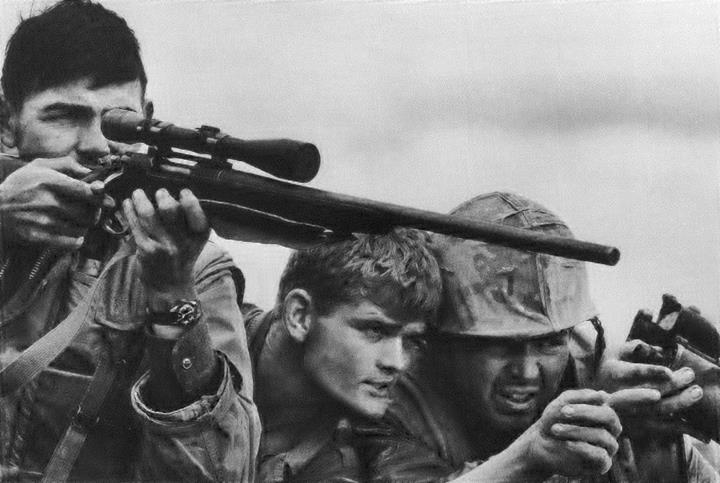
North Vietnamese Army leaders put a prize of $ 30,000 on the head of this man. About 93 Vietnamese soldiers were killed during the war.
As well as being the owner of a record of the greatest records of snipers in the US Marine Corps, but it has the advantage of being the most famous shot in the history of snipers in general; shot from a distance, to penetrate the lens of a Vietnamese sniper saw the taste of American soldiers tortures, Note the reflection of light on the enemy sniper's eye, and in a fraction of a second he fired his shot, which would not have hit her target with such precision if the snakes were not looking at each other at the same moment.
The name of Hattuck was synonymous with white feathers. He always kept one on top of his head, but the only task he abandoned was the greatest task he ever had.
First, let us bear in mind that he volunteered to do the job. Second, Hathcock had to crawl more than 1,500 yards into the enemy's territory to shoot the Commander-in-Chief of the North Vietnamese Army. Third, detailed information about the mission was sent to him only on the way to carry out his mission. The mission was four days and three nights and he crawled inches by inch. During that time, he was stung by a poisonous snake. A Vietnamese soldier stepped on his head without paying attention to the fact that he had stepped on him.
Despite this, Hathcock did not panic and put himself in his position, taking his position for correction, and as soon as the commander-in-chief arrived at his chest with a stroke in his chest, the soldiers began to look crazily for the signatory, but Hathcock crawled back where he came from, on him
- White Death "SimoHäyhä"
![SimoHäyhä.jpg]
(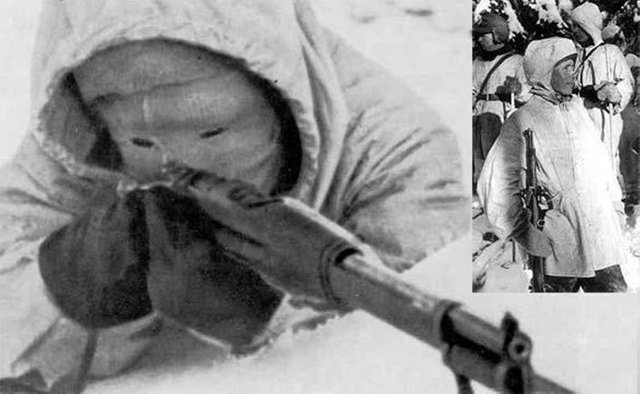 )
)
Master of snipers, legend of mythology, and the porter of proverbs in the world of wars,
Finnish Simo Haya, who killed alone more than seven hundred soldiers and a Soviet officer,
Five hundred with a sniper rifle and 200 with a machine gun, all in less than a hundred days, has the highest rate of fatal injuries confirmed in any war throughout history.
Haya, born in Rautjärvi, began his military service in 1925, but his duties as snipers began during the winter war between Russia and Finland in 1939.
Simo Haia worked in very harsh conditions, ranging from very low temperatures to 40 Celsius, and to do his job alone without the help of anyone. For three whole months, Haya would catch Russian soldiers alone.
In the beginning, the Russian generals were not interested in the fall of large numbers of soldiers, so the pace of the war goes on, but they lost their senses completely when they learned that the reason for the fall of all these victims is one man only.
They decided to take decisive action and sent a sniper to confront Haya. When the body of the sniper returned, they decided to send an entire team, but the number of casualties increased without finding a trace. The generals ordered the area where the Finnish sniper was stationed without decisive conclusions.
Haya was not a regular sniper. He was well aware of his environment, which he fought on his land and was good at uniting with. He also used a modified M28 rifle to fit his mansion, which did not exceed six feet, and an iron telescope that helps to correct more accurately and not expose it if it is reflected The sun's rays, or even a little glare from it, Haya surrounded the mouth of his gun with snow so that the snow would not be scattered when he fired his shot,
And his mouth is filled with snow so as not to condense and expose his position. At the top of all these precautions is his famous white coat, which made him just a piece of white snow that can not be distinguished from what surrounds it.